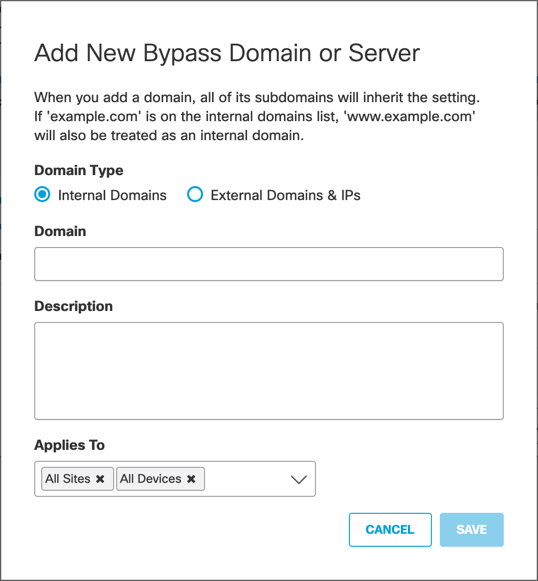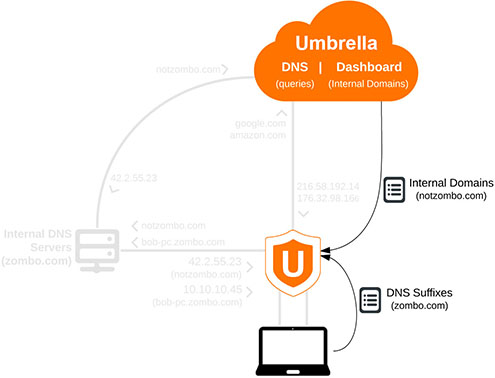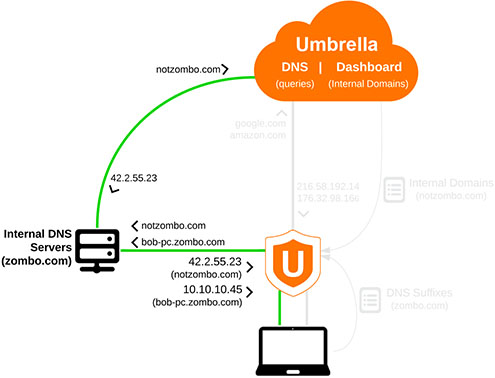Domain Management
By default, Umbrella will redirect all DNS queries to Umbrella – which may cause your local DNS to no longer resolve while using the roaming client. All refers to all domains except the local search suffix domain(s) and the default domains (*.internal and RFC-1918 reverse queries).
Domain Management (Deployments > Configuration > Domain Management) allows DNS queries for certain domains to query the local network's DNS servers directly instead of Umbrella when using the Umbrella roaming client.
Note: Domains on the internal domains list also apply to Secure Web Gateway traffic for the roaming security module as well as Umbrella PAC files. To bypass SWG without also bypassing DNS, use the External domains list.
Without specifying internal domains, all DNS queries are sent directly to Umbrella, and as a result, can't reach your network's local resources (for example, computers, servers, printers) on internally-hosted domains that rely on local DNS servers.
To ensure uninterrupted access to these resources, administrators should add the appropriate domains to the Domain Management section of the dashboard (Deployments > Configuration > Domain Management). This creates an internal domain allow list that will be synced to your roaming users. Essentially, the Internal Domain list allows all added domains to resolve DNS records as if the Umbrella roaming client was not installed on the computer.
The Umbrella roaming client determines which domains it should treat as internal domains based on the following two sources: Domain Management and DNS suffixes.
Table of Contents
Domain Management
Populate Domain Management (Deployments > Configuration > Domain Management) with domains used by your organization to access local resources while on the organization's network (at the physical location or connected through VPN). Internal Domains are pre-populated with the .local TLD and all RFC-1918 (private network) reverse DNS address space. Newly added domains will sync down to Umbrella roaming clients within about one hour.

Applies To—Allows you to specify whether the internal domains should apply to Umbrella roaming clients, virtual appliances (VAs) or both. All DNS queries are sent directly to Umbrella, and as a result, can't reach your network's local resources (for example, computers, servers, printers) on internally-hosted domains that rely on local DNS servers.
DNS Suffixes
The domains contained in the DNS suffixes configuration on a computer's adapter and global network settings are imported automatically into an individual Umbrella roaming client's Internal Domain list each time the Umbrella roaming client starts or a new network adapter (such as a VPN or Wireless connection) is initiated. This is to help Umbrella roaming clients adapt to foreign networks where they may want to access local resources without adding the domain through the dashboard.
The behavior of adding the domains contained in the DNS suffixes list can be disabled during installation using a an OrgInfo.json parameter.
Operational Flowchart
The following flowchart explains how the roaming client gracefully handles internal and external DNS queries:
1. Internal Domains
The Umbrella roaming client's Internal Domains list is populated by two sources:
- Syncing the Internal Domains list located in the Umbrella dashboard
- The DNS Suffixes list located in the local computer's networking configuration settings

2. External Queries
External DNS queries that do not match a domain located on either of the Internal Domains lists are sent straight to Umbrella.
3. Internal Queries
DNS queries for domains contained in the Internal Domain list are sent through the local network's DNS servers.
Internal Domains that are hosted on the local network are resolved by the Internal DNS server directly (as seen with "bob-pc.zombo.com").
Internal Domains that are not hosted on the local network are resolved by Umbrella or whichever public DNS servers are used for resolution (as seen with notzombo.com).

Advanced Topics
The following section focuses on more in-depth information and logic with internal domains and expected behavior.
Unencrypted
Although the Umbrella roaming client is able to send encrypted DNS queries to Umbrella when in the encrypted state, domains listed on the Internal Domains list are sent unencrypted, because they are not sent to Umbrella.
Virtual Appliances
If virtual appliances (VAs) are deployed at one or multiple locations within your organization, the Umbrella roaming client will disable itself and DNS settings will revert to the VA while connected to the location physically or through VPN. For more information about the Umbrella roaming client's behavior with VAs, see Virtual Appliances.
If all of your organization's locations are using VAs, configuring the Internal Domains list for Appliances only (not Appliances and Devices) will suffice; any time the Umbrella roaming client is not connected to the network in question, it will not use Internal Domains set to "Appliances Only", and treat any DNS queries to your domain as a public query (encrypted).
DNS Suffixes (Continued)
There are implications that should be considered with DNS Suffixes.
- This could allow an organization to not add any domains to the Internal Domains list in the dashboard. If DHCP is configured to use your domains as DNS Suffixes, the Umbrella roaming client will automatically know to treat the domain as local, even without adding it to the dashboard.
- If using DNS suffixes to rely on Internal Domains resolution instead of populating the list in the dashboard, as mentioned above, it means increased security. Since DNS queries sent to domains on the Internal Domains list are sent unencrypted, this implies that a machine performing DNS queries for domains that have been added in the dashboard is always sent unencrypted on all networks.
The behavior of adding the domains contained in the DNS suffixes list can be disabled during installation using a special command-line parameter.
Virtual Appliances < Domain Management > Configure Protected Networks for Roaming Computers
Updated over 1 year ago
